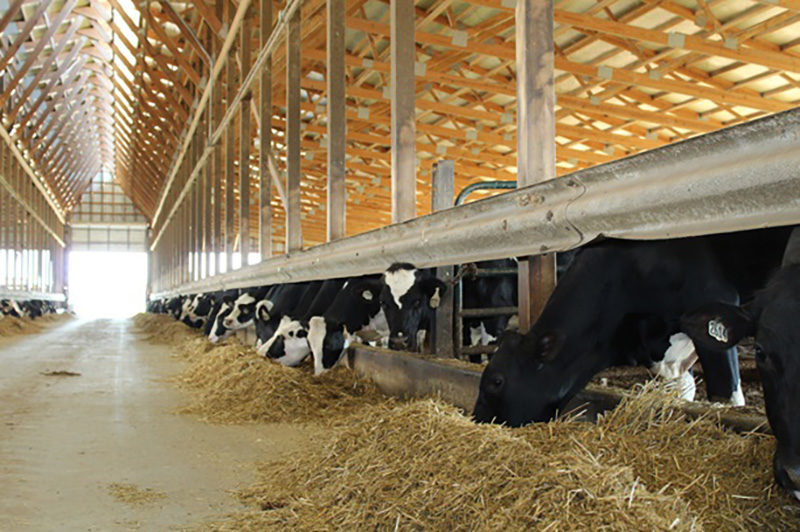We are all well versed in understanding acidosis, but do we truly understand the cost of a leaky gut? What was once a topic of pH has now transitioned into the wider impacts of microbiology, endocrinology, physiology and immunology. Here we will consider the connection between acidosis, leaky gut and the challenge of endotoxins, particularly lipopolysaccharides (LPS), being absorbed through the gut wall, causing an inflammatory response. We will also consider the mechanisms behind this inflammatory response and the energetic cost to fuel this.
Understanding Acidosis
Acidosis in cattle is a condition that arises primarily from difficulty feeding to meet requirements of high genetic-merit animals. It occurs when there is an overabundance of rapidly fermentable carbohydrates in the diet, driving the growth of amylolytic bacteria, an increase in the hydrogen sink, lactic acid, leading to a drastic reduction in rumen pH. This acidic environment hampers the normal digestion of feed and can cause a range of health problems for cattle, including laminitis, liver abscesses and a weakened immune system. Acidosis results in substantial financial losses for the beef and dairy sectors due to decreased production and treatment costs.
Stress and Leaky Gut
One of the previously less understood consequences of acidosis is its impact on gut health. In a healthy gut, tight junction proteins, on the lateral side of enterocytes, prevent pathogens entering the digestive tract and also prevent the gut from leaking bacteria into the lumen. During times of stress, for example heat stress, these tight junction proteins retract, making the gut more permeable. As well as events such as heat stress, it is thought that even a phycological stress can cause the retraction of the tight junction proteins.
Endotoxins: LPS challenge and the Inflammatory response
Endotoxins are toxins produced by bacteria, with lipopolysaccharide (LPS) being one of the most well known. In the context of acidosis, when the gut wall becomes more permeable, LPS can cross from the rumen into the lumen of the gut. A potent stimulator of the immune system, LPS is a pathogen associated molecular pattern (PAMP), that causes a Toll-like Receptor 4 (TLR4) mediated inflammatory response. When LPS crosses the barrier of the gut, a local inflammatory response will be stimulated. In worse cases, the LPS will enter the blood stream, and in the worst cases, the inflammatory response can become systemic.
This inflammatory response is a necessary defense mechanism designed to protect the body from infection. However, when triggered repeatedly or excessively, as in cases of leaky gut due to acidosis, it can become harmful to the animal's health. During an incidence of acidosis, there is an increased level of free endotoxin in the rumen due to an increased turnover of the microbial population, and so the challenge of LPS is greater.
Fueling the immune system – cost of Inflammation
The inflammatory response is a biological function that requires energy. Activated immune cells such as macrophages, require glucose to mount the inflammatory response. This energetic requirement is a must from a biological survival standpoint, and so energy is diverted from other partitions such as performance in milk or average daily gain. Work has shown that in a Holstein dairy cow, the energy requirement to fuel an active immune response, is around 4.4 pounds of glucose per day. That equates to 8.4Mcal of energy per day, or 15.4 pounds of milk. Often when we make changes to diets, we are looking to see 4.4 – 6.6 pounds of milk increase, and so a loss of 15.4 pounds is huge!
Conclusion
Acidosis in the beef and dairy sectors is a multifaceted problem that affects not only the physical health of livestock but also the economic viability of these industries. In the dairy sector in particular, there is also the hidden cost of subacute ruminal acidosis (SARA). The connection between acidosis, leaky gut and the absorption of endotoxins highlights the intricate relationship between nutrition, gut health and animal immunology.
One of the biggest challenges of mitigating the potential losses of acidosis, a leaky gut and an inflammatory response, is seeing that the challenge is present. Without taking blood samples to monitor the inflammatory response, practically, it is difficult to see. At times of stress, there may be a raised somatic cell count (SCC), however, there are many factors that can also cause a raised SCC.
The energetic cost of inflammation equal to 15.4 pounds of milk is significant, and nutritional approaches need to consider how to mitigate this. You wouldn’t inject a dose of E. coli into an animal on a daily basis, but that is effectively what you are doing if the rumen is not managed well. Feeding to manage the rumen or to mitigate the impact of endotoxins should be a part of all nutritional strategies, particularly for high-producing animals.
—Written by Sophie Parker-Norman - Volac Animal Nutrition






